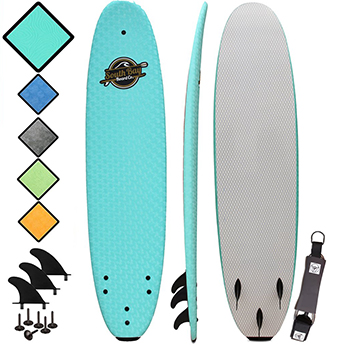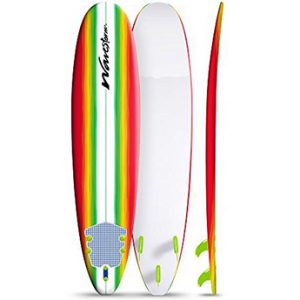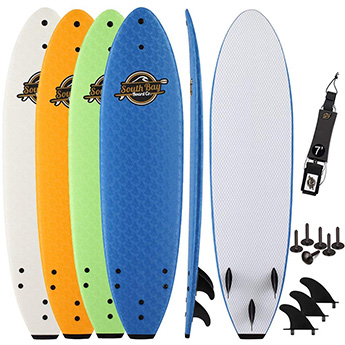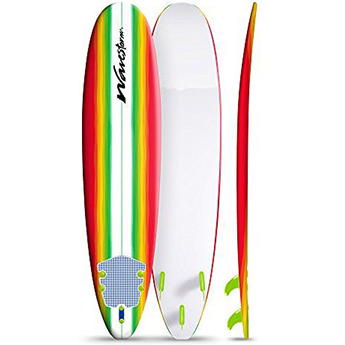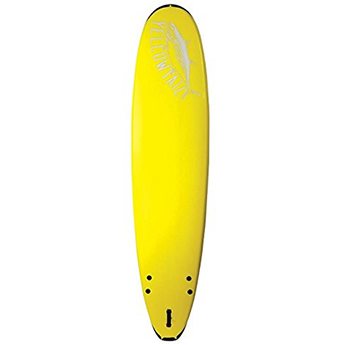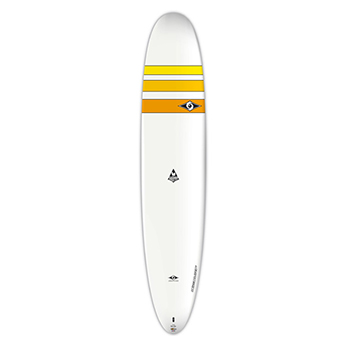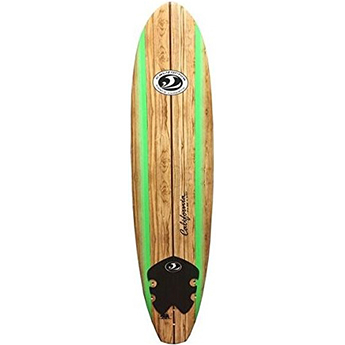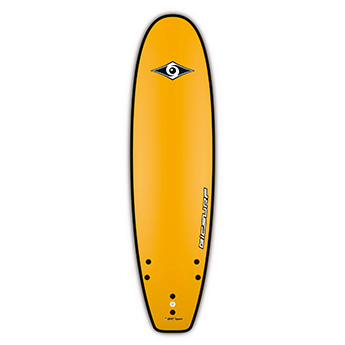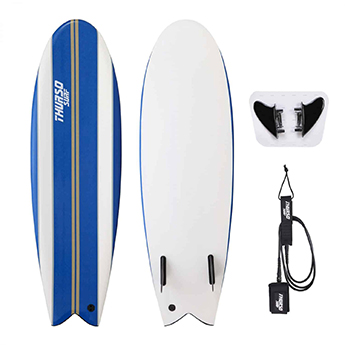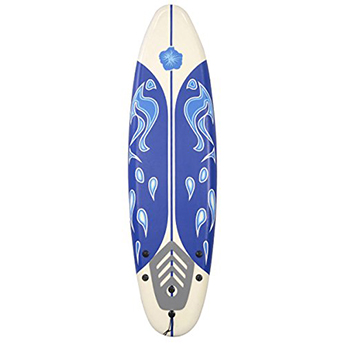If you’re just getting into the world of surfing, the last thing that you want to do is buy the wrong beginner board.
Buying the wrong board could lead to days upon weeks upon months of frustration while trying to learn how to paddle, pop-up, and catch a wave.
Instead of spending hours and hours sifting through the internet and visiting every surf shop you can possibly get to, just check out our list of the top beginner surfboards on the market to buy!
We compiled the best beginner friendly surfboards on the market into one seamless article.
These boards have great buoyancy, shape and materials that are perfect for adults and kids alike.
After purchasing any of the boards on this list, you can be confident that you’ll be popping up and surfing in no time!
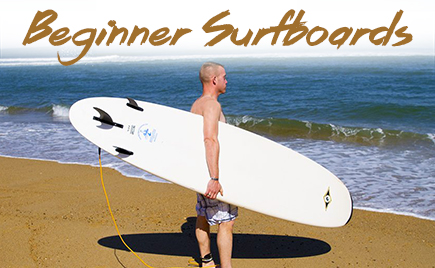
Contents
Best Beginner Surfboards
What Is A Beginner Surfboard?
Beginner surfboards are shaped for stability and balance. They are usually very thick, and most times made with strong epoxy resin or a foam top deck. Foam boards and epoxy boards are light and easy to paddle into waves. They also get damaged less than a traditional board that is made with polyester resin.
Adults should use a longer board to start surfing. This is because the extra surface area allows more time and balance to learn to pop up and stand on the wave. Usually boards with wide tails and round noses are used. A thin, skinny pointy board moves very fast, sinks into the water more and is very hard to learn to balance on.
Kids can learn on smaller boards, but a foam top board is still useful because it has extra buoyancy. The extra buoyancy means more waves, which means more practice time. Foam beginner surfboards are also safer because they are softer than traditional boards. And the fins are usually made from soft plastic as well.
The Top 9 Best Beginner Surfboards
Our #1 Choice - SBBC 8’ Verve Soft Top
Quality and superior shape design make the SBBC Verve 8’ a must have, whether you are learning to surf or want to mix up your quiver. This board can be ridden in small, mellow surf, or gnarly, big beater waves. It is durable beyond belief and super fun to ride.
The durability comes from top notch construction materials. The core of the board is made with closed cell high density polyethylene that is waterproof, and the slick bottom is 6 oz resin lined to avoid dings and scratches.
The fin holes are PVC lined so you won’t have to worry about water leaking in through the fins. Three stringers will keep the integrity of this board for years to come. One middle stringer is coated with fiberglass and the two side stringers are marine grade plywood.
The Verve 8’ gets some of it’s high performance capabilities from the double concave bottom deck. This allows the board to glide over the water and ease and not sink the rails. The pulled in square tail is ideal for turning, as are the hard rails around the deck. The nose of the board is slightly more narrow as well, so you won’t be at risk of pearling when you take off.
Wavestorm is one of the most popular brands of soft top beginner surfboards. You can get them for cheap and they’re even better brand new than a used beginner surfboard. The quality is top of the line, as they use only the best materials. You’ll have this board in your quiver for a lifetime.
The cross-link top deck is made from watertight EPS foam and wrapped in ultra strong WBS-IXL light resin. The deck has traction so wax is not needed. There are also three stringers that will hold the board’s shape no matter what beating it takes. The slick bottom is made from smooth high density polyethylene, perfect for gliding down the wave.
The Wavestorm 8’ Classic is very thick, while still being made of safe, soft foam. The extra thickness gives this board great buoyancy, while reducing risk of injury should the board hit you when you wipe out. The deck is nice and wide too, so learning to stand up will be easier. The beginner friendly shape of this board will give you the stability and momentum to get into waves and ride down the line
Every Wavestorm is sold with very easy to install pop through fins, so you’ll be immediately ready to surf. You’ll also get a leash and leash string with your purchase. With all the extra gear, board performance and ultra tough construction, it’s no wonder why the Wavestorm 8’ Classic makes our list of top best beginner surfboards.
#3 SBBC Ruccus 7’ Soft Top
South Bay Board Company produces almost every shape and style of foam top surfboards imaginable. For the smaller adult, teen or child, the 7’ Ruccus provides the same buoyancy and durability, but with less volume. The smaller board is ideal for smaller folks who want to learn to shred.
Boards with less surface area are easier for smaller adults, like women, or kids to maneuver. But at 22” thick, wave catching is no problem. The thick rails are perfect for learning to balance, as is the wide deck. More skilled surfers can ride this board too! The narrower nose and pulled in squash tail are great for increased maneuverability.
Durability is a must with kids beginner surfboards. Younger folks tend to be hard on their equipment, and increased safety is also important. The 7’ Ruccus is designed to be super tough, but also very safe to surf on. The soft EPS foam is great for catching waves but also reduces the risk of injury in the case of a collision with the board or another surfer. The foam is also waterproof and puncture resistant.
The bottom deck is made with HDPE material that has impact dispersing netting. This technology is great for protection against pressure dings and scratches. There are two marine grade wooden stringers and one fiberglass stringer in the board. Three stringers will maintain board shape for as long as you can ride it.
A leash, leash string and easy to install fins come with this board, so it is surf ready as soon as you get it. It’s the perfect board for learning, or shredding small, fun waves.
#4 Surftech 8’ Soft Top
If you are looking for the safest foam top beginner board on the market, the Surtech 8’ Soft Top is it. With rubber safety pads on the nose and tail and ultra soft foam and fins, you won’t have to worry about injury while surfing. THe deck is also bright yellow so other surfers will see you from a mile away.
Not only is the board very safe, it is also very durable. It can withstand being dropped, washed into rocks or slammed into the sand by waves and it won’t damage. The EPS foam is watertight and incredibly resistant to punctures and scratches. The HDPE slick bottom is also resistant to scratches and dings. The board won’t break due to the three stringers that run from nose to tail.
The Surftech 8’ Soft Top is shaped for beginners and more advanced surfers alike. It is thick and voluminous so beginners can have an easier time learning to paddle into waves. The wide deck and round nose increase the surface area of the deck which is great for learning to stand up on the wave. If you are a more advanced surfer, you can easily ride this board like a traditional nose rider and do cool tricks.
This classic longboard shape is great for beginners and advanced longboarders. It has the width, length and buoyancy for learning to stand and catch waves, while also being shaped to do advanced tricks on, like riding the nose. The epoxy deck make the BIC Sport ACE-TEC super durable and resistant to dropping, scratches from rocks, or dings.
The best thing about this board is that it will grow with your surfing level. Learning to pop up? This board glides smoothly in the whitewash while you are acquiring balance. It has great maneuverability which is ideal for learning to trim and turn. The concave nose will not sink in the wave if you are trying to hang ten.
Ace-Tec epoxy is incredibly durable. You’ll have this board in great shape for years of surfing. The fins are durable and high performance. The BIC Sport 9’ comes with an FCS 10” middle fin and two FCS G-L side fins. Probably the most versatile board on our list, The BIC Sport ACE-TEC 9’0 epoxy board is a great investment for the lifelong surfer.
#6 California Board Company 7’
California Board Company 7’ is another great kids and women beginner surfboard. It still has high volume and great buoyancy, but is slightly smaller for easier maneuvering. It can also be ridden by more advanced surfers who are looking for great wave catching capability in smaller surf.
As with all CBC boards, the building material is high grade and the shape of the 7’ is world class. The core and top deck is made with EPS watertight foam that will resist waterlog and decay. The high density polyethylene slick bottom is ultra hydrodynamic for a smooth ride down the line. You’ll be guaranteed board strength with the three stringers inside, breaking and damage won’t be an issue.
Kids will like this board because of the cool aesthetic. The wooden graphics and neon green stripes wrap the bottom and top deck to make this board stick out in style in any line up. The CBC 7’ gives the illusion of old school wood without the cumbersome weight and rigidity. A traction pad and easy to install pop through fins make this board surf ready right after purchase. You’re kids will be carving up the waves in no time!
BIC is a leading brand in beginner surfboards and the Sport G-Board EVO is a great example. The materials of the board construction are very durable and the shape is perfect for learning to ride waves. This model comes in a 5’6”, 7’0”, 8’0” and 9’0” size, so surfers of every size and shape can enjoy it. The round nose and squash tail gives good balance for beginners, but are also maneuverable for more skilled surfers on smaller waves.
The 5’6” is ideal for small children learning to surf, as it is easier to maneuver down the wave. An advanced surfer looking for a challenge will also enjoy this size, too. The 7’0” is great for smaller women or teens, and the 8’0” and 9’0” is great for taller adults, like men.
As with all BIC boards, the EVO is made to take a beating. The foam top is watertight and won’t waterlog. The HDPE bottom is smooth and resistance to scratches and punctures if it gets dropped or hits rocks. Whether you are a little tike or a big guy, this model is great for all sizes of beginners.
Novelty boards are all the rage right now and the Thurso 5’10” Fish is a unique and fun shape. Perfect as a kids beginner surfboard or an advanced surfer looking to add an interesting board to their quiver. The quality of this board makes it a great investment for kids and adults.
Closed cell EPS foam makes up the top deck and is watertight and damage proof. The bottom deck is made from heat laminated HDPE and is responsive and maximizes speed on the wave. The board is thick, light and buoyant so you’ll be catching waves for hours!
The two wooden stringers add rigidity and strength, while still have flex for seamless turns. Kids will enjoy how easy it is to turn this board and adults will be impressed with the responsiveness. The fish tail adds great surface area to the board for stability while little surfers are learning to pop up and stand on the wave.
The Thurso Surf 5’10” Fish comes with a 6’ leash with stainless steel swivel, easy to install twin fin set, and a top deck with traction so no wax is needed! Kids can learn on this board and it will grow with their skill level. Adults can ride this board for a fun challenge in smaller waves. A great board for anyone’s collection.
The Giantex 6’ Foamie is an ideal surfboard for kids! It is light, buoyant and extremely maneuverable. Kids can learn to pop up and balance, as well as progressing into more advanced waves and tricks. The blue and yellow flame graphics are very stylish and cool that kids love. Adults who want a great small wave board will love the Giantex 6’, too.
The EPS foam core is flexible for responsiveness but also rigid to maintain board shape and integrity. It is also watertight to prevent waterlogging and decay. The top deck around the foam is made with an EPE foam layer that is UV and scratch proof.
A leash, traction pad and pop through fins are included with your purchase. It will be ready to surf and you’ll have your little surfing shredding before you know it. Because this board can be ridden at all levels of surfing ability, it is the perfect investment board and can be surfed for years to come.
How To Choose a Surfboard For Beginners
Types of Surfboard
There are three basic surfboard types. “Fiberglass” boards, epoxy boards and soft top or foam boards. Fiberglass boards are the traditional design, while epoxy and foam boards are slightly newer technology.
Fiberglass boards are constructed with foam core blanks that are layered with fiberglass and polyester resin to give them strength and structure. Polyester resin is great because it creates and glossy, smooth surface and is easy to shape. It glides through the water very well and creates really cool deck designs.
The down side of fiberglass with polyester resin is that is can get damaged a little easier than epoxy or foam top boards. It is also the heaviest board medium. The top deck of fiber boards always require wax so your feet don’t slip off in the ocean.
Epoxy resin is very easy to shape, and produces a matte finish over the fiberglass. Epoxy is actually stronger than polyester resin, and thus becoming a popular replacement among shapers. Epoxy also dries quicker, so wait time for a board is shorter.
There are many surfers who swear that polyester boards ride better. In my opinion, polyester fiberglass boards are more responsive, but epoxy boards float better and are easier to get into waves. It all depends on what you want.
EPS foam core boards do not need top coats of resin and fiberglass, and as a result are cheap (low cost) beginner surfboards. Which is a good idea if you are still trying out surfing before you make the investment of a hard board.
EPS is also waterproof, whereas foam cores in boards with fiberglass are not. If you ding or put a whole in the deck of a fiberglass board, it will waterlog, and the foam might even start to rot. EPS foam boards have a slick, plastic bottom, but the rails and top deck are all made from the soft foam. Sometimes a shaper might add a smooth, very light coat of resin, but only for keeping the foam smooth.
Foam boards are the most buoyant type of surfboard. They aren’t quite as responsive as polyester or epoxy boards, but they catch waves the best. This is a good idea for a beginner. When starting out, you want a nice stable board that isn’t too responsive, otherwise you’ll lose your balance.
Foam top beginner surfboards are also good because they are very wide and slow moving, giving the newbie surfer plenty of time to pop up and practice balance on the wave.
Size
For beginner boards, you generally will need a board that is a good ratio to height and weight. Same goes for kids. As you progress, you can always go shorter. Starting out, you’ll need enough volume to support your weight and improve your balance on.
Average to larger sized male adults should look for a board that is at least 49 liters and 8’ tall. Smaller women and younger teens and children can go even smaller. There are many size charts you can consult on the internet and in surf shops.
Price
Beginner surfboards are usually pretty inexpensive. Sometimes people try surfing and they end up not liking it. It’s better to buy a cheaper board for this reason when you are starting out. You would hate to buy a 1500 dollar board just to find out you don’t like surfing! For kids, they outgrow gear very quickly, so that’s an even better reason to keep your purchase on the cheaper side.
Beginner Surfboard Size Chart
Board Size | Weight |
|---|---|
6’0’’ | >100 lbs |
7’0’’ | 100-125 lbs |
7’6’’ | 125-150 lbs |
8’0’’ | 150-200 lbs |
9’0’’ | 200+ lbs |
How To Get Started
Beginner Beaches
Good beginner beaches typical have waves that are consistently smaller and softer. You want a wave that moves slower so you have more time to try to pop up. Smaller waves also move slower and are easier to maneuver on. Beaches like Waikik in Hawaii, Blackies in Newport Beach, California and the Jersey Shore in New Jersey are great examples of beginner beaches.
If you aren’t sure where beginner beaches are around you, it’s best to ask your local surf shop or do some research on the internet. Learning to read waves takes time, and you never want to put yourself in a situation that is out of your skill level. The ocean is unpredictable and caution should always be exercised.
How to Surf for Beginners
The first thing you want to do is take a lesson. It’s near impossible to learn to surf on your own. I have seen a lot of beginners put themselves in dangerous situations and develop bad habits from not learning about how the ocean moves or proper technique from an instructor.
Practice makes perfect. Do as many pop-ups as you can after you learn how to do them on land. This will train your muscles and it will be easier to pop-up in the water.
Start in white wash. White wash moves slower and is easier to stand in. When you see the white wash coming, position your board towards land and start paddling.
When you feel the push of the white wash, use your popping up skill you’ve been practicing.
After popping up, practicing staying on your board by widening your arms out and slightly bending your knees. This will lower your center of gravity and give you extra balance. Try riding all the way to shore!
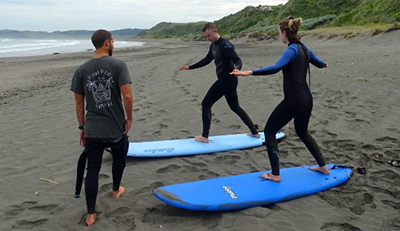
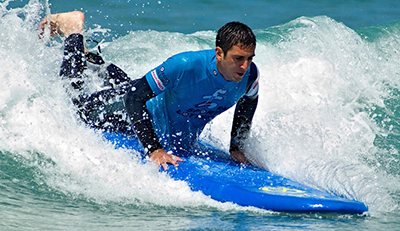
Beginner Surf Tips
Respect the line-up. When you advance to surfing waves BEFORE they have broken, you’ll be surfing with people that are more skilled and know surf etiquette really well. Make sure you learn how people take turns catching waves, and who gets the right of way.
Don’t drop in on people. The easiest way to ruin the vibe in the line up is to take waves that you don’t have the right of way on. If someone is closer to the peak of the wave or already standing up, they have the wave. There’s always another wave!
Learn how the ocean works. Take as much time as you can to learn how tides, currents and wave energy works. It will keep you safe and help you catch more waves.
Be nice and have fun! Surfing is supposed to be fun, and there’s never a reason to get upset about it. When you paddle out, don’t be a wave hog and be nice to other surfers.
Health benefits of surfing
As with any exercise, increasing your heart rate and using muscles results in more endorphins. Endorphins make you happy! If you exercise regularly, you will be a happier person. The added element of the ions in salt water will only elevate your mood that much more!
Surfing is also incredibly good for your muscle retention and joint health. You’ll gain endurance muscle from paddling and standing up on the wave. Since surfing is low impact, you’ll be able to keep your joints active without friction impact that you would get from sports like running.
Being in nature is our natural element and it reduces stress considerably. There have been numerous studies which show how being in nature on a regular basis has reduced people’s stress levels. This is really good for your blood pressure and heart health.
Surfing exercises for beginners
Cross training is a good idea for any sport. Here are some good exercises you can do on land to optimize your time in the water.
Squats: you’ll be squatting on your surfboard quite a bit, so practicing squats on land is a huge help. Start with your feet shoulder width apart. While keeping your back straight, slower lower until your knees are almost at a 90 degree angle. Pause for 5 seconds, then come back up. I would recommend starting with three sets of 10, but you can increase as much as you’d like.
Push-ups: Paddling requires a lot of arm muscle, and pushups can build your endurance. While doing pushups, try not to lower your chin below your elbows, as it can be bad for the joints.
Jogging/running: Long distance jogging and running exercises increase cardiovascular endurance, which you’ll need in the water.
Swimming: If you hate running or have knee issues, swimming is also a great way to increase cardiovascular fitness and increase paddling power. Try doing some laps at your local pool, or in a body of water that is safe from intense currents.
Surf etiquette for beginners
1. Only paddle out in conditions that are appropriate for your skill level. Waves and water conditions ath are out of your experience puts you and other surfers at risk for injury or worse.
2. Wait your turn. Any level of surfer knows not to paddle straight to the beginning of the line up as soon as you get out in the ocean. Figure out where the wave is breaking and when it will be your turn by starting on the shoulder of the wave. Gradually ease towards the peak when everyone has already had their turn and you feel comfortable in the conditions.
3. Never let your board go! Always wear a leash. If you are paddling out and a wave crashes on top of you, don’t just throw your board to the side, hold on to it as best you can. Having a stray board in the line up means collision and injury to other surfers. You quickly will be known as a kook for losing your board.
FAQ
How much are beginner surfboards?
Beginner surfboards are typically made with plastic or foam materials that are cheaper than traditional fiberglass and polyester resin. They also have plastic fins that are good for beginners and HDPE bottom decks that are cheaper material as well.A typical board for an averaged sized adult will be 8’0” to 10’0” long and will range you from $250 to $500. You can get a used beginner surfboard for slightly less.
Where can you buy the best beginner surfboards?
If you are looking for the best beginner surfboards at the best deals, i woulndt stray from this list. The top quality and performance are all listed right here on this website. If you want to buy one from another source, however, surf shops and used sport goods websites are great places to start. A warning, however, you won’t be guaranteed amazing quality and wave performance like the boards on our list of top ten beginner surfboards.
What are beginner surfboards made out of?
Most beginners will fall a lot when learning to surf. If their board doesn’t hit them after a wipe out, it most certainly will hit another surfer. Beginner surfboards are usually made with soft foam or light epoxy to reduce chance of injury in case a collision happens.
Epoxy and foam are much stronger than traditional fiberglass boards. They don’t ding as easily, won’t waterlog and are resistant to punctures and holes. While learning to handle a surfboard, more durable material is always a good idea.
How long are beginner surfboards?
Board length depends on the size of the surfers. Typically, a longboard, like an 8’ or 9’ is best for an adult. The extra length and volume will be great for learning how to stand and practice balance. Children or smaller teens who are learning don’t need so much size, so it’s good to start them on smaller boards. The size chart listed above is a great reference.
Final Thoughts - Which Should You Get?
For kids, the CBC 7' beginner surfboard or the Giantex 6' Foamie are great. They are light and thick with great buoyancy. This will make it easy to learn how to pop-up, balance on the wave, trim and turn. Since they are shorter in size, kids and teens won’t have any problem maneuvering them.
If you are an adult, my top recommendation would be the SBBC 8' Verve Soft Top. It is made with top grade materials and is perfectly shaped for beginners. The wide tail and nose give the deck great stability for learning to stand. The thickness and buoyancy are perfect for getting into waves and the watertight EPS foam is great material for reduced risk of injury and damage to the board. Before you know it, you’ll be up and surfing in no time!
OUR #1 PICK - SBBC 8’ VERVE
Our Rating

Jasmine Oneill Martin // Team Writer
